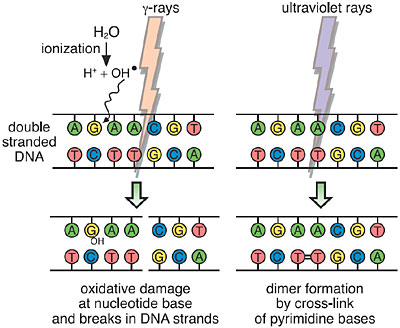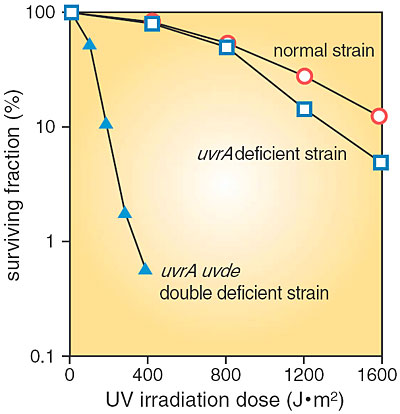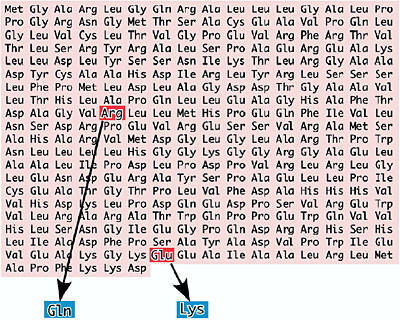In recent years, increase of harmful ultraviolet rays caused by depletion of the ozone layer has come under close scrutiny. It is estimated that O2 began to be released into the atmosphere by photosynthetic microorganisms 1.9 billion years ago, culminating in accumulation of ozone surrounding the earth, thus protecting it from cosmic radiation and solar ultraviolet waves. A stable stratospheric ozone layer was formed about 500 million years ago, when O2 concentration in the atmosphere reached 20%. After formation of a stable ozone layer, it was possible for living organisms to survive on the ground.
The type of DNA damage induced by ultraviolet radiation is different from that induced by ionizing radiation such as gamma-rays (Fig. 6-9). Deinococcus radiodurans, which is known as a radiation-resistant bacterium, also exhibits very high resistance to ultraviolet rays (Fig. 6-10). This bacterium is considered to be a survivor which acquired resistance not only to ionizing radiation but also to ultraviolet radiation in the course of evolution after its appearance about 2 billion years ago.
DNA damaged by ultraviolet radiation can mainly be repaired via photoreactivation and nucleotide excision repair processes. Despite of the lack of a photoreactivation repair pathway in D. radiodurans, mutants deficient in a prokaryote-type nucleotide excision repair are known to show resistance to ultraviolet rays. The reason why repair-deficient mutants do not exhibit ultraviolet sensitivity has been a longstanding mystery. This mystery has been solved by our discovery that D. radiodurans possesses a eukaryote-type nucleotide excision repair gene, as do Neurospora and budding yeast, as well as a prokaryote-type nucleotide excision repair (Fig. 6-11). In other words, D. radiodurans developed two independent repair pathways (prokaryote-type and eukaryote-type) in the evolutional process, and the function of these two pathways renders this bacterium extraordinarily resistant to ultraviolet rays.
|


